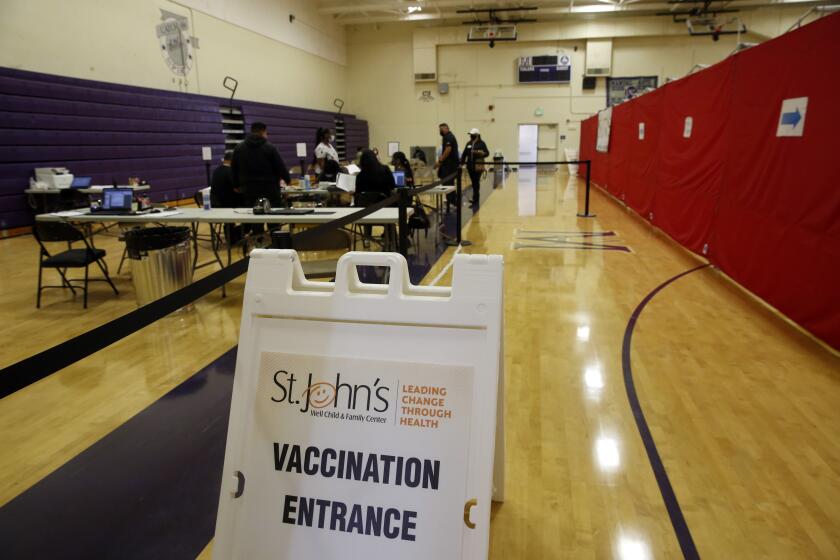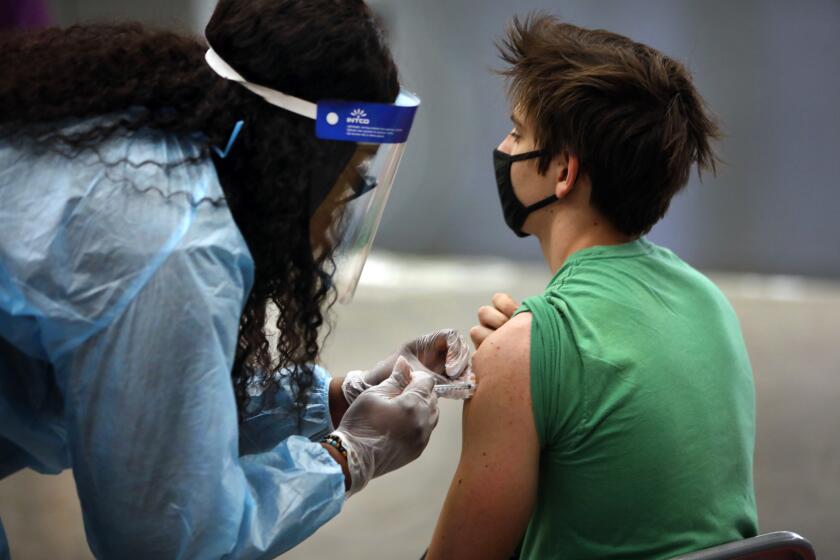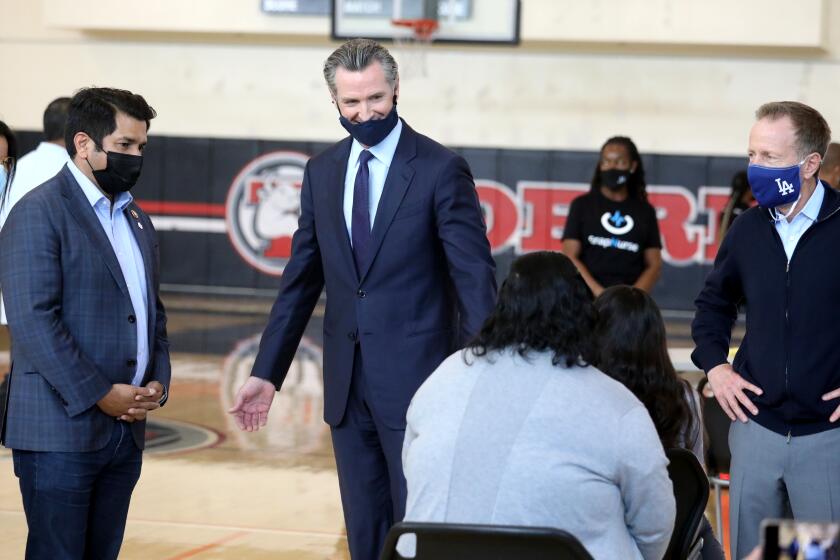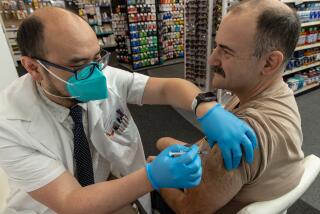Black residents now have the highest risk for COVID-19 in L.A. County
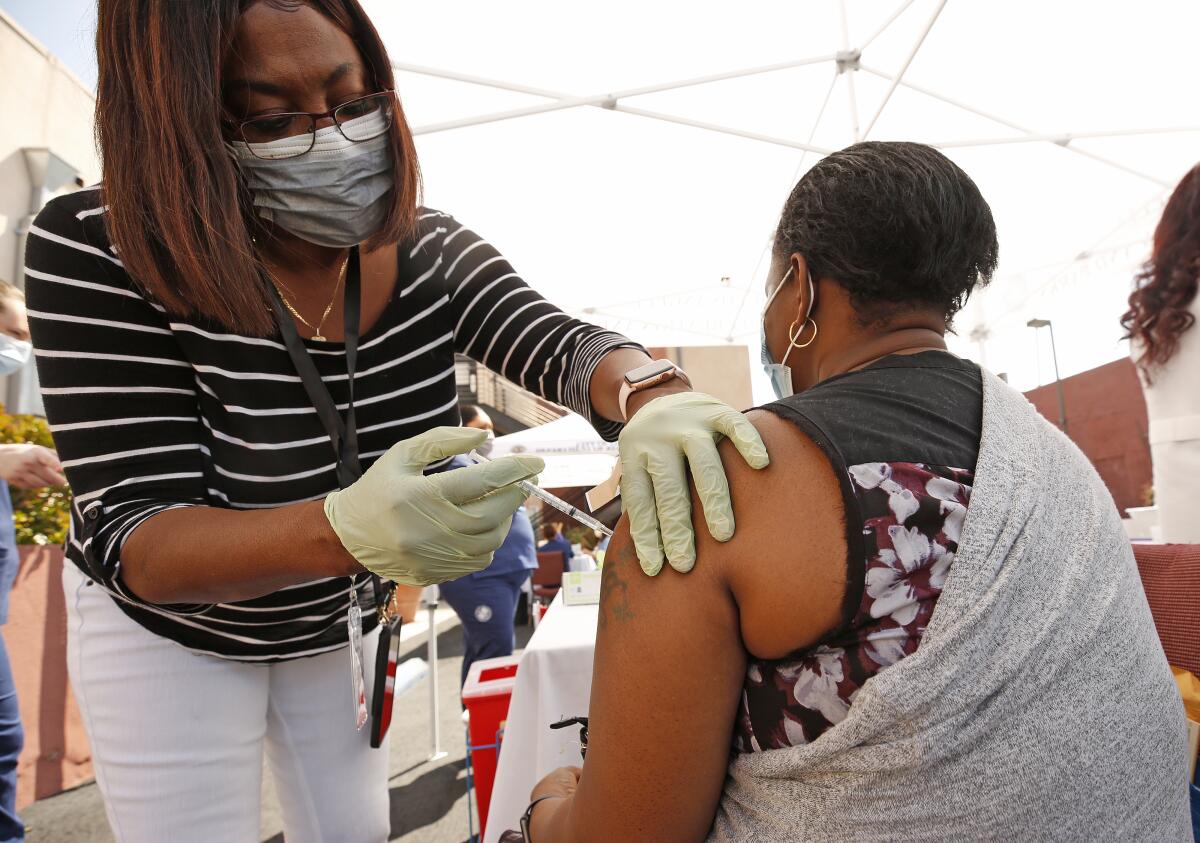
In a troubling shift, Black residents of Los Angeles County now have the highest risk of coronavirus infection and COVID-19 hospitalizations and death of any racial or ethnic group, new data show.
Since the first few months of the pandemic, Latinos in L.A. County have been the hardest-hit group; the COVID-19 death rate among Latino residents surpassed that of all other racial and ethnic groups for the first time 11 months ago and remained the highest for both the second and third waves of the pandemic.
For the record:
6:14 a.m. June 25, 2021This article gives an incorrect timeframe for the data cited. It references newly diagnosed daily coronavirus cases reported over a recent six-week period. In fact, the data were cumulative over a recent two-week period.
But in recent weeks, there’s been an unmistakable shift, and now Black residents are twice as likely as Latinos and three times as likely as white and Asian American residents to die of COVID-19.
The latest maps and charts on the spread of COVID-19 in Los Angeles County, including cases, deaths, closures and restrictions.
Black residents are also twice as likely to contract the coronavirus than white or Latino residents of L.A. County, according to data presented by the Department of Public Health.
Over a recent six-week period, a daily average of 45 newly diagnosed coronavirus cases were reported for every 100,000 Black residents. Yet for every 100,000 white and Latino residents, there were roughly 25 newly diagnosed coronavirus cases a day; and for every 100,000 Asian American residents, there were 11 new coronavirus cases a day.
In terms of COVID-19 deaths, for every 100,000 Black residents, about one person a day died of the disease during the same period. By contrast, the daily death rate was about 0.5 per 100,000 Latino residents; the rate was about 0.34 deaths per 100,000 residents for white and Asian American people.
Those rates are far lower than they were during the peak of the pandemic. Daily coronavirus cases overall are still declining in L.A. County and are at their lowest levels since March 2020. The most recent coronavirus positivity rate for L.A. County is 0.5%.
Nonetheless, the latest data are a warning sign of what could come if vaccination rates do not dramatically improve among Black residents.
Just 40% of Black residents 16 and older in L.A. County have received at least one dose of vaccine — the lowest percentage of any racial or ethnic group. Among similarly aged Latino residents, 48% are at least partially vaccinated, as are 62% of white and 71% of Asian American residents.
“Who is getting infected and who is in the hospital is likely a reflection of … lower rates of vaccination in some of our hard-hit communities,” L.A. County Public Health Director Barbara Ferrer said.
About 35% of Latino and 36% of Black California residents are at least partially vaccinated, while 52% of white and 63% of Asian American residents are.
“This is going to mean that we have to continue to both bring vaccine to the places where people live and work, and we need to work hard to get high-quality information about the vaccine to those with questions about the vaccines’ safety and effectiveness,” Ferrer added.
The relatively lower vaccination rates among Black and Latino residents have long been a warning sign for officials. Should too few Black and Latino residents get vaccinated before California fully reopens its economy, these communities of color — by virtue of having more unvaccinated people — will continue to be at higher risk for COVID-19 outbreaks and death.
“Where we have lower vaccination rates, it’s going to be more and more likely that those — unfortunately — will be people who are more easily infected, end up being hospitalized and tragically may pass away,” Ferrer said. “If we can’t narrow the vaccination gap pretty quickly, we, I think, will see once again, this tragedy around disproportionality in who has the most devastating health outcomes.”
Warning signs are not only popping up in L.A. County. In the nation’s capital, Black residents make up 45% of the population but 82% of new coronavirus cases over the most recent 10-day period, according to a Washington Post analysis. While 19.8% of Black residents in Washington have been fully vaccinated, 28.8% of white residents are fully vaccinated.
Dr. Kirsten Bibbins-Domingo, chair of UC San Francisco’s Department of Epidemiology and Biostatistics, in a tweet expressed dismay at the disparity in Washington. “The consequences of failing to focus on those most affected throughout the pandemic is devastating,” Bibbins-Domingo wrote.
More than five months into the inoculation campaign, a vast gulf has opened between the most- and least-vaccinated of California’s 58 counties.
Surveys show that officials need to do more to reach out to Black and Latino communities about how and where they can get vaccinated.
A Kaiser Family Foundation survey found that Black and Latino residents were twice as likely as white residents to not have information about where to get a COVID-19 vaccine.
Black and Latino adults were more likely than white adults to worry about missing work because of vaccination, not being able to get the shot from a place they trust, having to pay for the vaccine (even though it is free) and about difficulty in getting transportation to a vaccine site, the Kaiser Family Foundation found.
Young Black and Latino adults are also more likely than young white adults to want to “wait and see” before getting a COVID-19 vaccine, the foundation found in its polling.
As a result, officials have been trying to establish more mobile vaccine clinics in areas where people lack easy access to transportation. L.A. County has also set up a website for people to request a vaccine clinic be established at their workplace, organization or special event.
President Biden has said employers can get tax credits for providing paid time off for employees who need to take time off work to get the vaccine and deal with mild side effects — such as a fever or fatigue — that are common a day after getting the shot.
California will offer what appears to be the largest COVID-19 incentive in the nation: the chance for 10 residents to win $1.5 million apiece.
State and local officials have started to turn to prizes to renew interest in vaccinations.
In L.A. County, officials announced a sweepstakes for which the grand prize is season tickets for Kings hockey games or Galaxy
soccer matches. Angelenos can become eligible by getting their first COVID-19 shot — or the second, if they bring someone to get their first dose too — through Thursday at vaccine clinics run by L.A. County, the city of Los Angeles or St. John’s Well Child & Family Center, which operates in communities hardest hit by the pandemic.
Statewide, Gov. Gavin Newsom announced the Vax for the Win program, which aims to give out $116.5 million in cash and other prizes for vaccinated people. The grand prize offers the chance for 10 California residents to win $1.5 million apiece.
Officials hope the programs will help give people extra incentive to get vaccinated.
More to Read
Sign up for Essential California
The most important California stories and recommendations in your inbox every morning.
You may occasionally receive promotional content from the Los Angeles Times.

